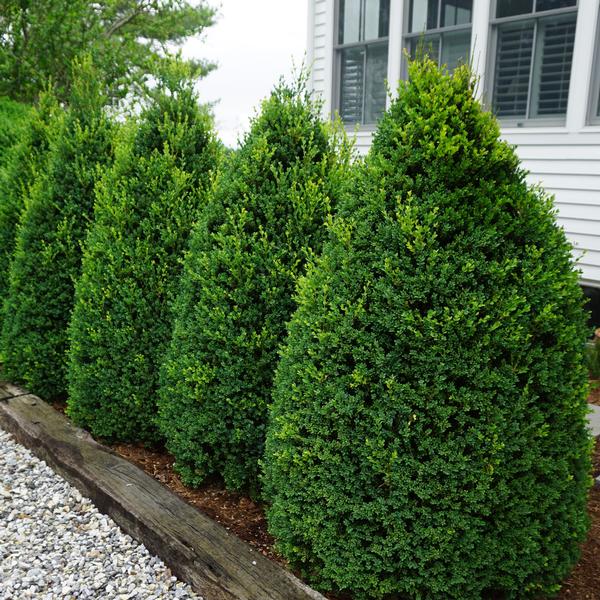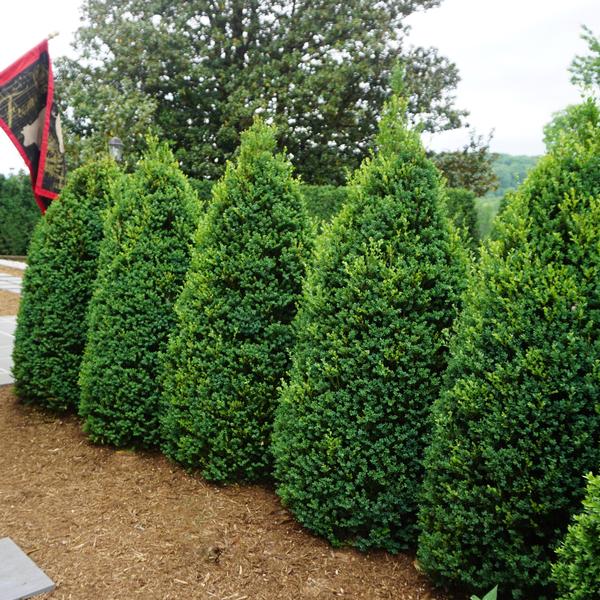Buxus microphylla 'John Baldwin'
John Baldwin Boxwood
‘John Baldwin’ is grown for its true, broad, conical habit. Foliage is fine-textured and leaves are relatively small compared to many boxwood. New foliage has a blue tint which will slowly fade to a blue-green. Use this cultivar as an alternative to ‘Green Mountain’ when a true conical shape with minimal pruning is desired. Also, use it as an excellent substitute for conical Japanese hollies in sun or shade. Deer resistant.
- » Medium growth rate; 2"-3" per year
- Category:Shrubs
- Hardiness Zone:6-8
- Tall:4 Feet
- Wide:3 Feet
Attributes
| • | Evergreen |
Foliage Color
| • | Green |
Wildlife
| • | Deer Resistant |
Growth Rate
| • | Medium |
Boxwood Exposure
| • | Sun (Location is sunny from late morning to late afternoon) |
| • | Shade (Location has no direct sun) |
| • | Part Shade (Location is primarily shaded from late morning to late afternoon) |
Boxwood Zone
| • | Zone 6 (Average Annual Minimum Temperature -10 F to 0 F) |
| • | Zone 7 (Average Annual Minimum Temperature 0 F to 10 F) |
| • | Zone 8 (Average Annual Minimum Temperature 10 F to 20 F) |
Boxwood Foliage Color
| • | Blue (New foliage is blue and matures to green) |
| • | Green (Foliage is Predominately Green) |
Boxwood Best Usage
| • | Containers |
| • | Foundation Plant |
| • | Hedge Medium (Mature size of 4 to 8 ft) |
| • | Specimen Medium (Mature size of 3-5 ft high and wide) |
Additional Information about Buxus microphylla 'John Baldwin'
‘John Baldwin’ is grown for its true, broad, conical habit. Foliage is fine-textured and leaves are relatively small compared to many boxwood. New foliage has a blue tint which will slowly fade to a blue-green. Use this cultivar as an alternative to ‘Green Mountain’ when a true conical shape with minimal pruning is desired. Also, use it as an excellent substitute for conical Japanese hollies in sun or shade. Deer resistant.
Growing & Maintenance Tips for Buxus microphylla 'John Baldwin'
Up to 2 ft. or so in height, prune ‘John Baldwin’ in late winter to early spring to develop a conical habit. Once the plant gets 2-3 feet tall, it requires less pruning, typically having to remove only side shoots or “horns” each late winter or early spring. Use hand pruners or shears although shears are seldom needed as plant matures. Thinning is not necessary but, as with any boxwood, will help increase airflow and sunlight penetration into the interior of the plant.
‘John Baldwin’ is somewhat susceptible to boxwood leafminer but very tolerant to boxwood blight. It has few other pest or disease issues when planted and cared for properly.
Interesting Notes about Buxus microphylla 'John Baldwin'
Comment: This may be the best pyramidal growing boxwood that we have seen. Being a microphylla, it is proving to be more durable with regard to disease and its adaptation to a wider range of soil conditions. We have seen it perform well in marginally wet locations; however, we don’t recommend planting any boxwood in areas where drainage is poor.
Uses: Medium specimen, medium hedge, foundation plant, container
Substitutes: ‘Green Mountain’, ‘Dee Runk’, ‘Fastigiata’


